Can toxic indoor mould cause immunosuppression?
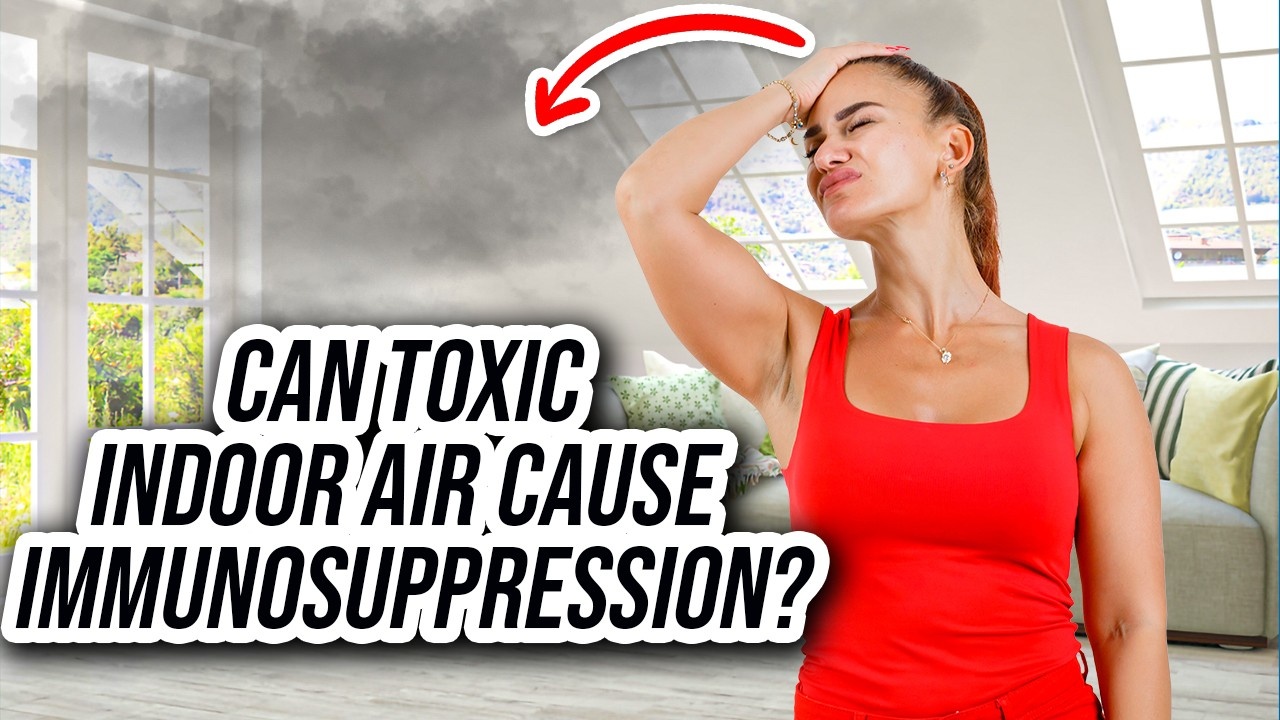
Hello, and welcome to The Mould Show. My name's Dr. Cameron Jones, your host, and today we're going to be focusing on water-damaged buildings, but specifically, we're going to be looking at how you go about measuring the impact of that water damage, that mould exposure and whether or not that is leading to obviously a range of adverse health symptoms that many people experience when they spend time indoors with mould. But how does this affect your immune system? Is there a way of firstly measuring the impact that the water-damaged building and the toxic components that are present in these environments? How do they affect your immune system? That is the topic of today's show, and that is can toxic indoor air cause immunosuppression?
What I'm going to be doing is that I'm going to be focusing on this piece of research that we're going to be drilling into in quite some depth and it's a really important piece of research. It came out at the beginning of 2022 and the topic focus of this is all about toxic indoor air and its ability to cause immunosuppression and a whole constellation of adverse health impacts. What is this research doing? They're looking at whether there is a set of causes termed the etiology between the symptoms experienced by occupants of a workplace and the presence in the building of what is termed toxic dampness microbiota. To get some classifications out of the way first off, dampness and mould hypersensitive syndrome is how we describe the environment which leads to a whole host of polymorbidities and potentially systemic inflammation.
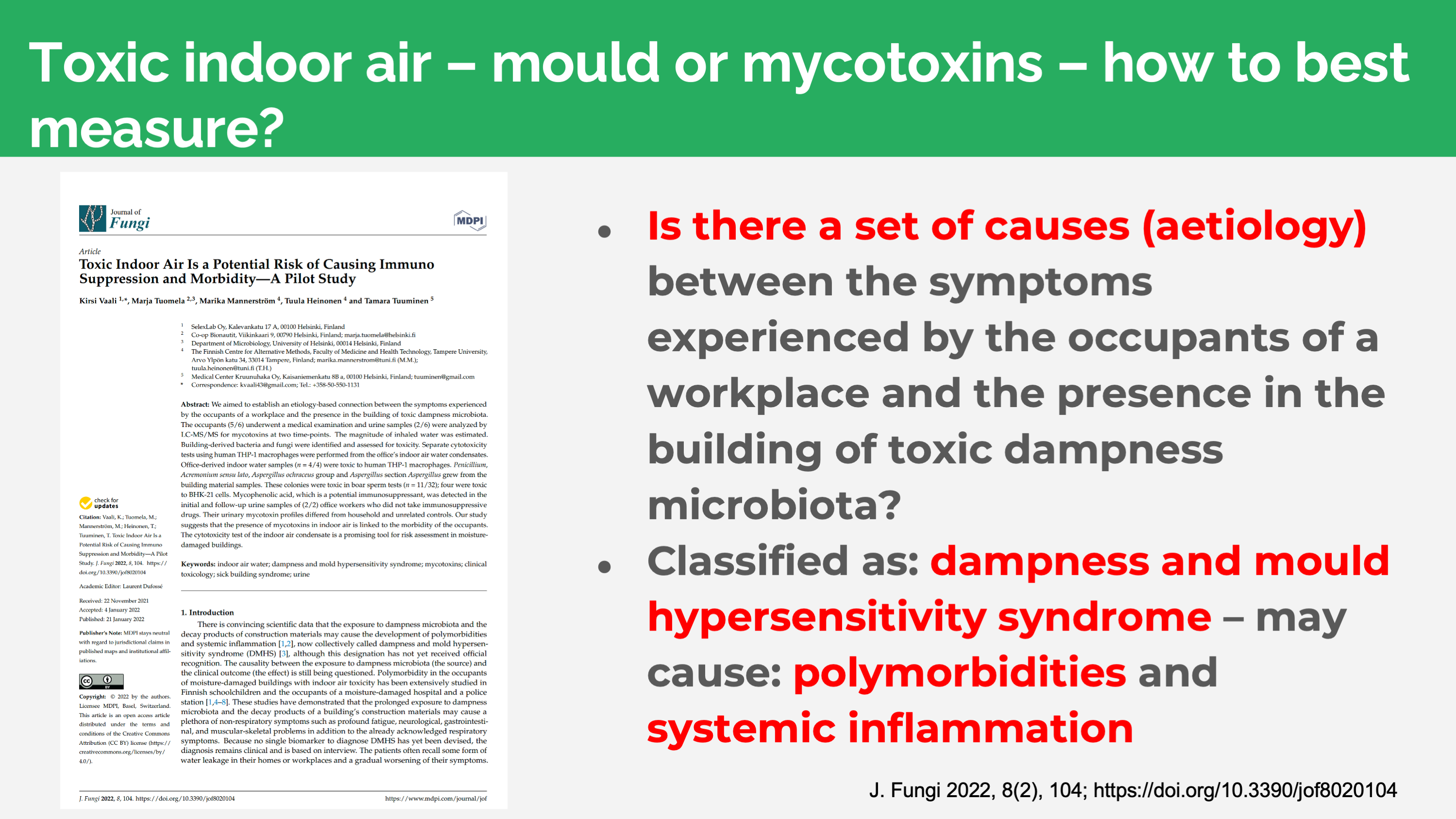
But what is the layperson's interpretation of what this publication is all about? Well, I want to tell you a story. It is focusing on a small group of people working in an office building. Now, they moved the offices to the ground floor and the building that they chose to occupy was just a little bit underground. Now, over the next three months, everyone who worked inside that building experienced a whole range of adverse health symptoms, and it got so bad that every single one of the staff presented, firstly, to their clinician.
This was research done in Finland and the clinicians teamed up with some scientists and they have done, really, what I consider to be one of the best publications that's come out in the water-damage literature for 2022 and it's this one. Certainly, you're going to be able to retrieve this from the links in the show notes and certainly, if you are listening to the podcast, you'll be able to get it there as well as on YouTube as well.
But what I want to get across is that when we're talking about exposure to water-damaged building interiors, obviously many people experience a range of adverse symptoms, and we've certainly gone over the constellation of symptoms, really, very often on The Mould Show, but just to review some of these typical problems. Headaches. When you spend time in a water-damaged building interior, it's not just the mould spores that you're being exposed to, but it is the micron and the sub micron fungal fragments that aerosolize and are present in the airspace and that you breathe these in. When you breathe these in, obviously they present a challenge to your mucus membranes, your ear, nose, and throat location in the body and that can cause coughing or sneezing or sinusitis.
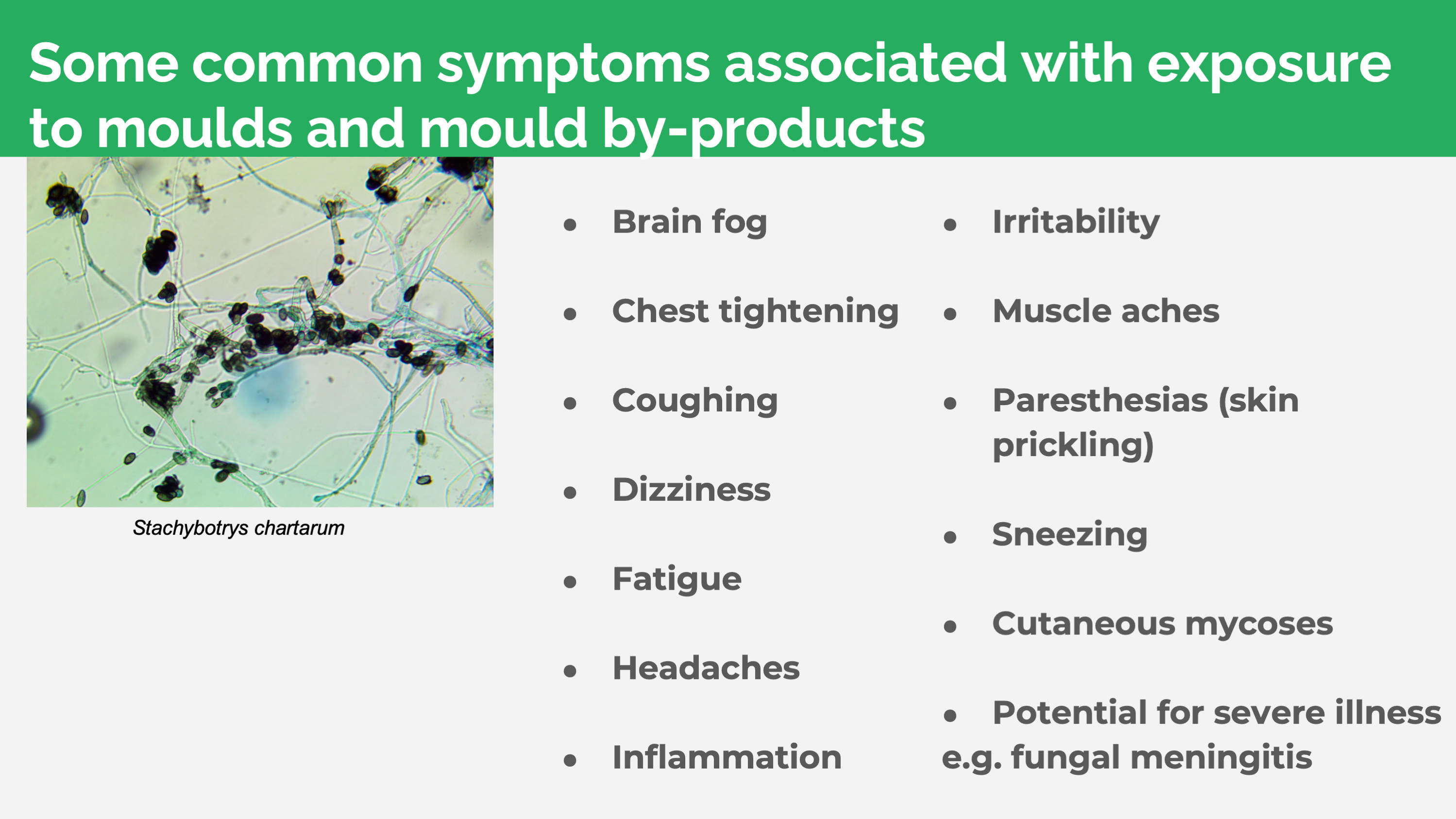
Over time, you may become quite severely irritated. Those skin cells can become inflamed, and that can often lead to a systemic infection in your sinuses or even in your inner ear. There may be, over time, prolonged exposure to the water-damaged fragments and cells and everything and the mycotoxins present in these environments. You may experience chest tightening, maybe even psychosomatic issues like irritability or an increase in anxiety or even feelings of sadness or depression. We need to be very mindful of these.
But when we are looking at this particular publication, why this is such an important publication, because it's been going a little bit more in-depth to understand and characterize these water damage buildings. For example, when people ring my company up and they're asking for an indoor air quality mould assessment, we will commonly measure things like the presence or absence of visible mould, whether or not the airspace presents with an odor, whether there is a visual evidence of mould or water damage in the premises, whether or not the spore levels between indoors and outdoors, and more specifically throughout the building, are showing elevated levels compared to the control, and also, too, what one would expect the levels to be for a normal environment, a normal mould ecology versus one that is showing examples of severe water damage or mould. These are the common ways that we quantify this.
But when these same individuals go to their healthcare provider or their medical practitioner, often they will be offered something interesting called a mycotoxin urine test, and we're going to be drilling into this now because this is fundamental to understanding this particular publication and certainly, it's a really interesting test because it is a biomarker test looking for specific mycotoxins that are present or accumulate in the patient, those individuals that we assume are exposed to water damage buildings and we assume that there is a causal relationship between their exposure to this environment and adverse health.
The premise to this publication is that the scientists did two things. They were examining obviously the building to prove that there was in fact water damage evidence and how they did that was classical microbiological testing, but also they do something unbelievably elegant. They have started to collect the water vapor in the air. Now, let me repeat that. Not only are they testing for the presence of microbiological markers like spores and whether or not there is active microbial growth that you can see on a Petri dish, for example, but they're also collecting the condensation.
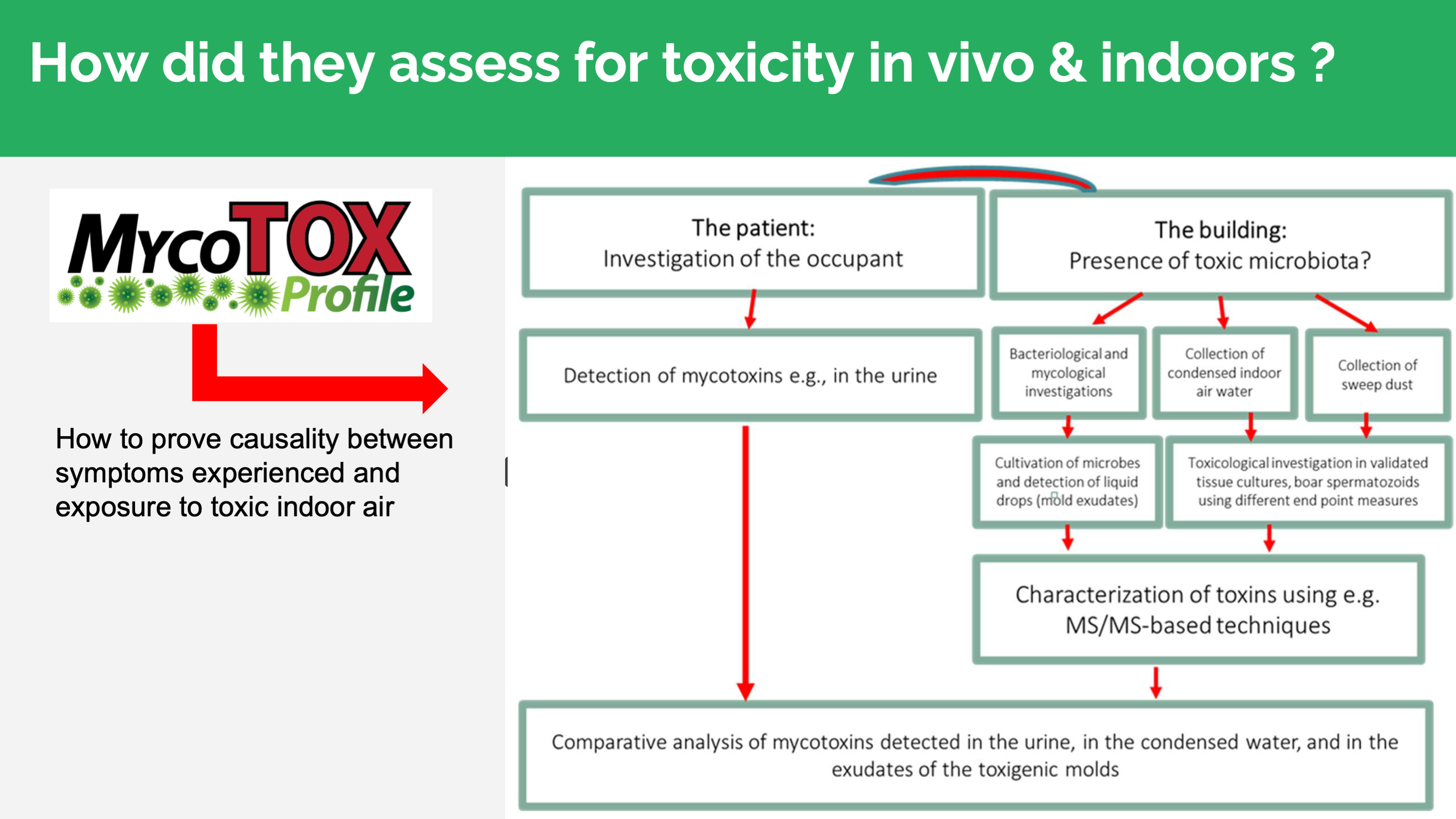
Why might you want to do that? Well, in any environment, there is water vapor in the air and that water vapour, the premise to this publication is that is capturing some of the toxic chemicals that are present in the air space given off by the fungi growing on the water damaged building elements, and that you are breathing these in. It's not just the particle challenge from the spores, but it's also the mycotoxins that are present in the water vapor which becomes contaminated because the building's contaminated. This is the basis of this publication and it is really elegant research.
What else am I going to show you and tell you about this? Well, the scientists have developed a way of collecting this water vapor containing supposedly the toxic material. How have they done this? Well, it's an adaptation of what I call the Coke can effect. If you grab a can of soft drink out of the fridge, for example, and you've got ambient temperature or a reasonably warm temperature inside your property, you are going to see condensation forming on that can. What these scientists have done is they have developed and patented a metal plate which they can rapidly cool down using dry ice, and by doing this, they are then creating crystals out of the water vapor which is condensing on the surface. It's basically a rapid way to collect the water vapor and then test that as a sample instead of measuring for active spores.
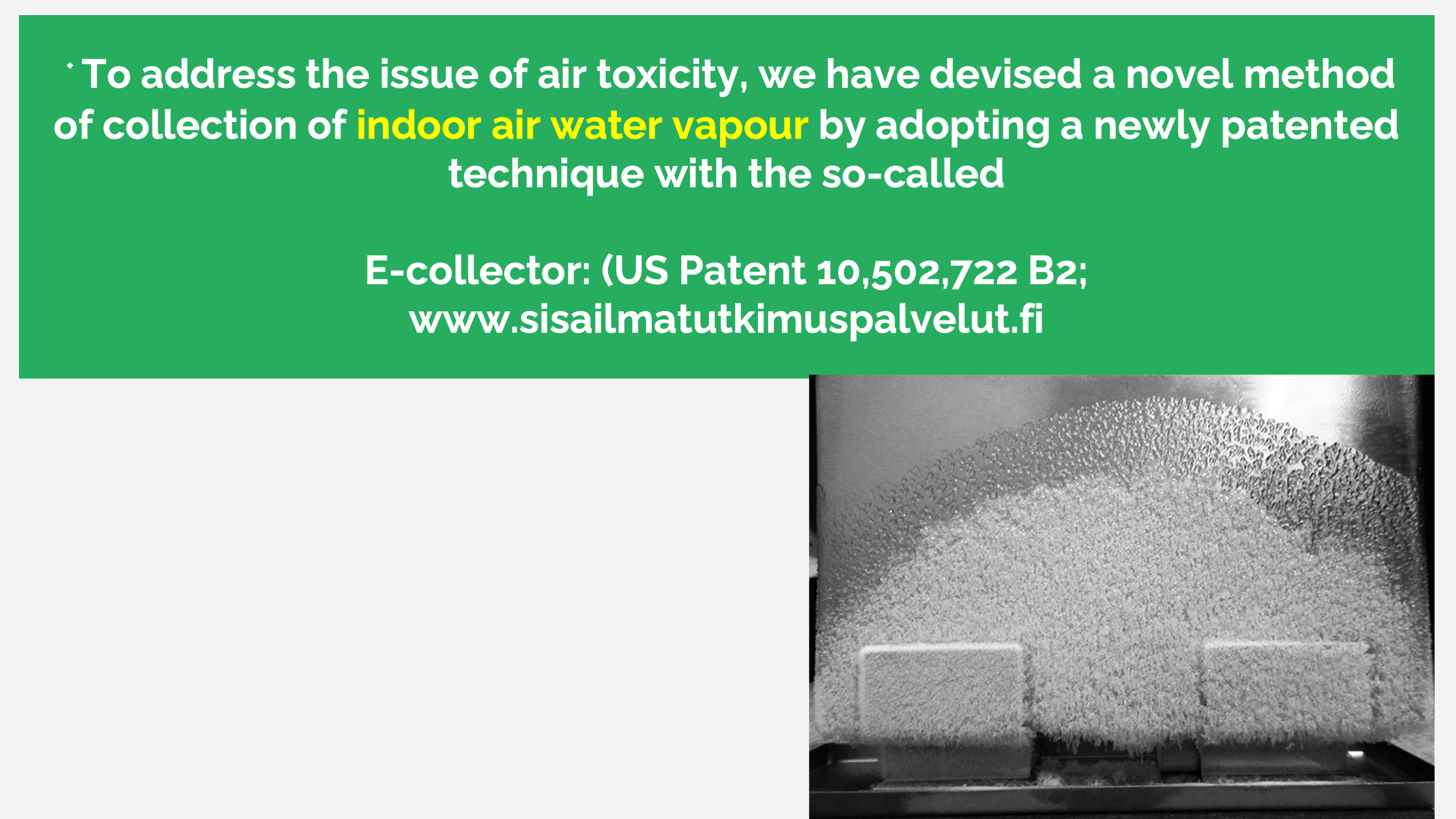
Again, for anyone that has a tightly built apartment that doesn't ventilate very well and has quite stagnant and stale air, many occupants of those buildings experience, particularly over the winter months when they're warming the indoor air, you will get condensation forming on cold surfaces like window panes, and especially at the basis of walls, especially if they have rising damp type conditions. This experiment is allowing you to capture the water vapor and then test that for the presence of toxins.
Now, moving right along. I want to talk to you about the three types of tests that these scientists have done. Firstly, and just to summarize, they're going into these buildings and they are testing them using classic microbiology. Then the patients who experience the adverse health symptoms are having their urine tested for mycotoxins, and we'll talk about that in a few minutes. But they're also assaying or testing the water vapor to see what it does to three types of cells, and we're going to go through each one of these cell types now, because it's really important that you understand this. This is essentially doing in vitro testing for toxicity.
The first type of cell line is called THP-1. This is a type of macrophage and this is a white blood cell in your body and it is in fact distributed throughout all of the organs of your body and it is part of your immune system. Macrophages are able to digest or destroy foreign substances like invading bacteria and yeast and fungi and even viruses and, of course, cancer cells as well. They also have the ability to recruit other elements of your immune system by presenting some of these foreign invaders to T cells, which is another component of your immune system, and this is intimately connected with inflammation because they release cytokines. This is the infamous cytokine storm that we've heard so much about in COVID-19 and SARS infections with coronavirus.
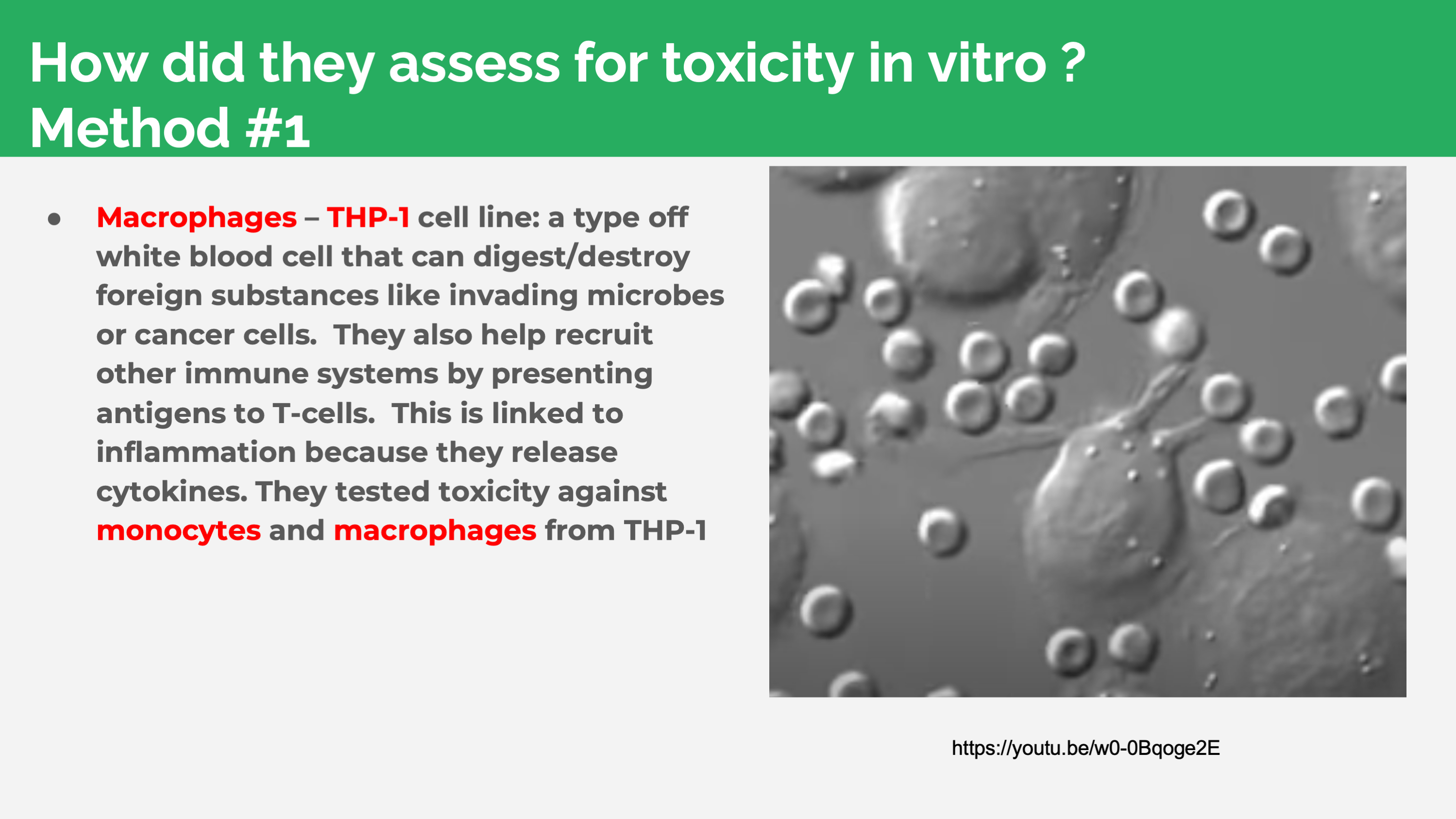
Now, what these scientists did is that they tested the toxicity of, firstly, parts of the cell, but also the condensed water vapor against monocytes and macrophages, and monocytes, in their own right, are very interesting because they're a component of your immune system and they are capable of degrading things like a gram-negative bacteria. It's really important that you understand that they tested the condensate against macrophages. You can see there's a photo I've put up of a macrophage here, and essentially, what this is doing is it is degrading or taking in those very small particles, not the blood cells, which are the circular ones, but the tiny little dots, they're invaders. Think of them like the bacteria or the things that make you sick. Your macrophages are fundamentally important for maintaining good health.
Now, let's move right along because the next type of in vitro test that they used was to assess what the implication of exposure to the condensate was on baby hamster kidney cells. They have the acronym BHK-21 cells, and these are common cell lines used to assess viral infections and they are often used as an alternative to animals to assess the toxicity of drugs. They're very important because you can work out whether or not that particular drug or chemical that you're testing against interferes with the growth. There has been some really elegant use of baby hamster kidney cells to determine whether or not buildings show the presence of lead paint, for example. We all know that over time, lead paint fragments from certain selected indoor surfaces, that becomes airborne and that lead can have an adverse health consequence, especially to young children.

These BHK-21 cells were used in some of that seminal research to quantify the adverse health consequence of exposure to lead. These Finnish scientists are using the same type of toxicity cell line to work out whether exposure to toxins that are present and invisible in the air in the water vapor are also causing a toxic chain reaction.
Next, we have boar sperm. Note, this is not going R-rated. Boar sperm has been used as a biosensor for detecting toxins in indoor dusts and bioaerosols. You might be asking, "Well, why did they use this particular type of cell?" They did this because sperm is highly dependent on mitochondria for energy, and therefore, any drug or toxin can be tested to see how it might interfere with motility to determine the impact on mitochondrial transport. This is really elegant research because for the first time, we have first-person observation of the impact of exposure to water-damaged building interiors where all the office workers become unwell with a constellation of different adverse health symptoms. They tested their urine, they measured mycotoxins and then they collected the water vapor out of the air and tested it against these three different cell lights. I'm going to show you what the results of this were.
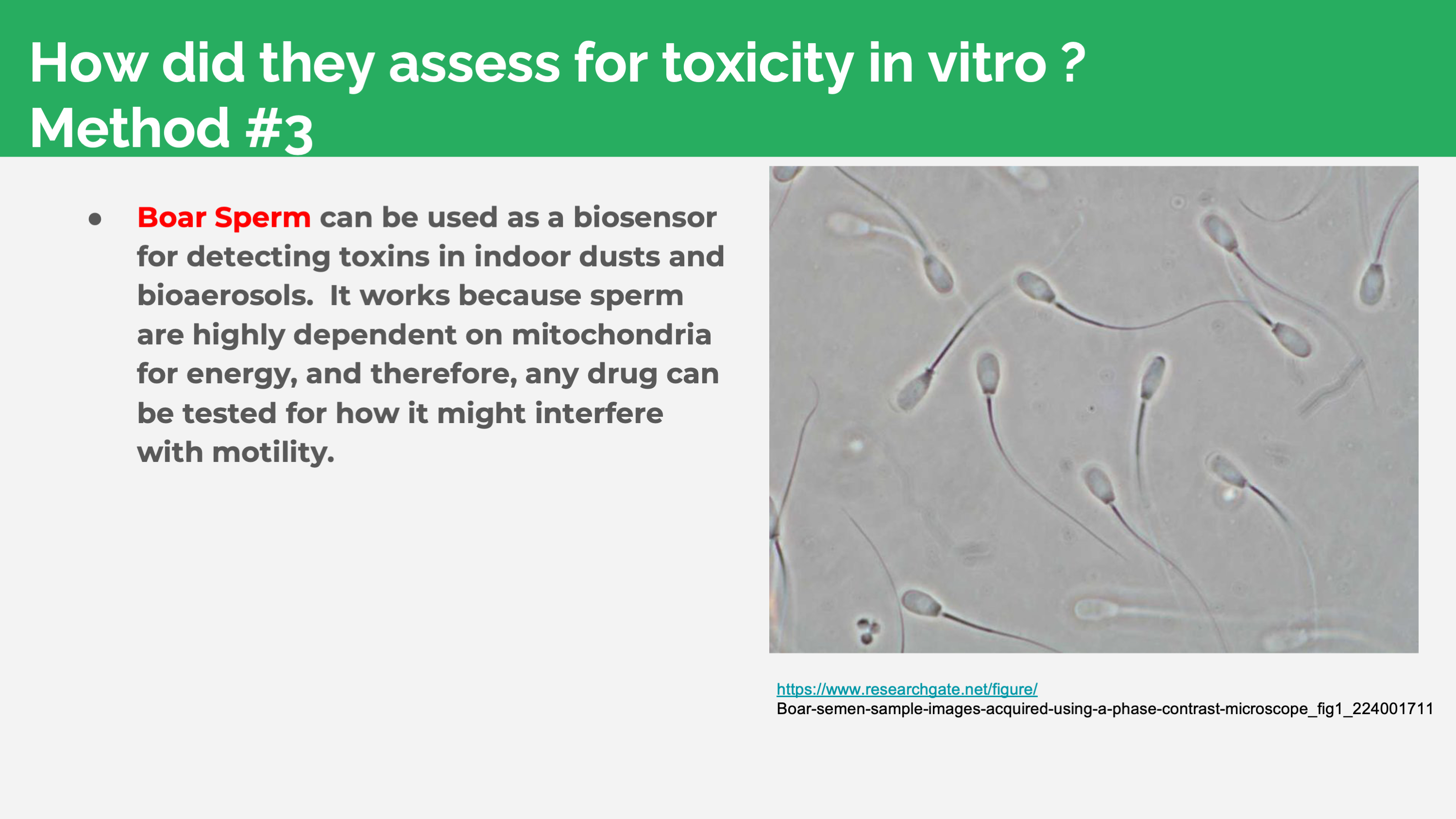
But we are going to continue tracking through because I just want to backtrack a little bit and I want to talk to you about the Mycotox Profile. Now, basically, there is a laboratory in the United States and many clinicians send urine samples from their patients off for testing, and this is an example from their website showing you the type of results that you are likely to see when you have your urine screened. Stachybotrys, of course, is an extremely well-known fungal microorganism that is often found on water-damaged building materials and there's a range of clinical literatures which show that it is particularly serious as to be exposed from.
If you were to get your urine tested and you'd been exposed to Stachybotrys, for example, you might have a lab test returned similar to this, showing both the metabolite, the mycotoxin, and whether it's in the normal or abnormal range. This is really interesting research in its own right, but the take-home message from this slide is that mycotoxin urine testing is something your clinician might elect to do to work out whether or not you are showing an accumulation of these mycotoxins, which might be causally connected to your adverse health symptoms and maybe something in the building.
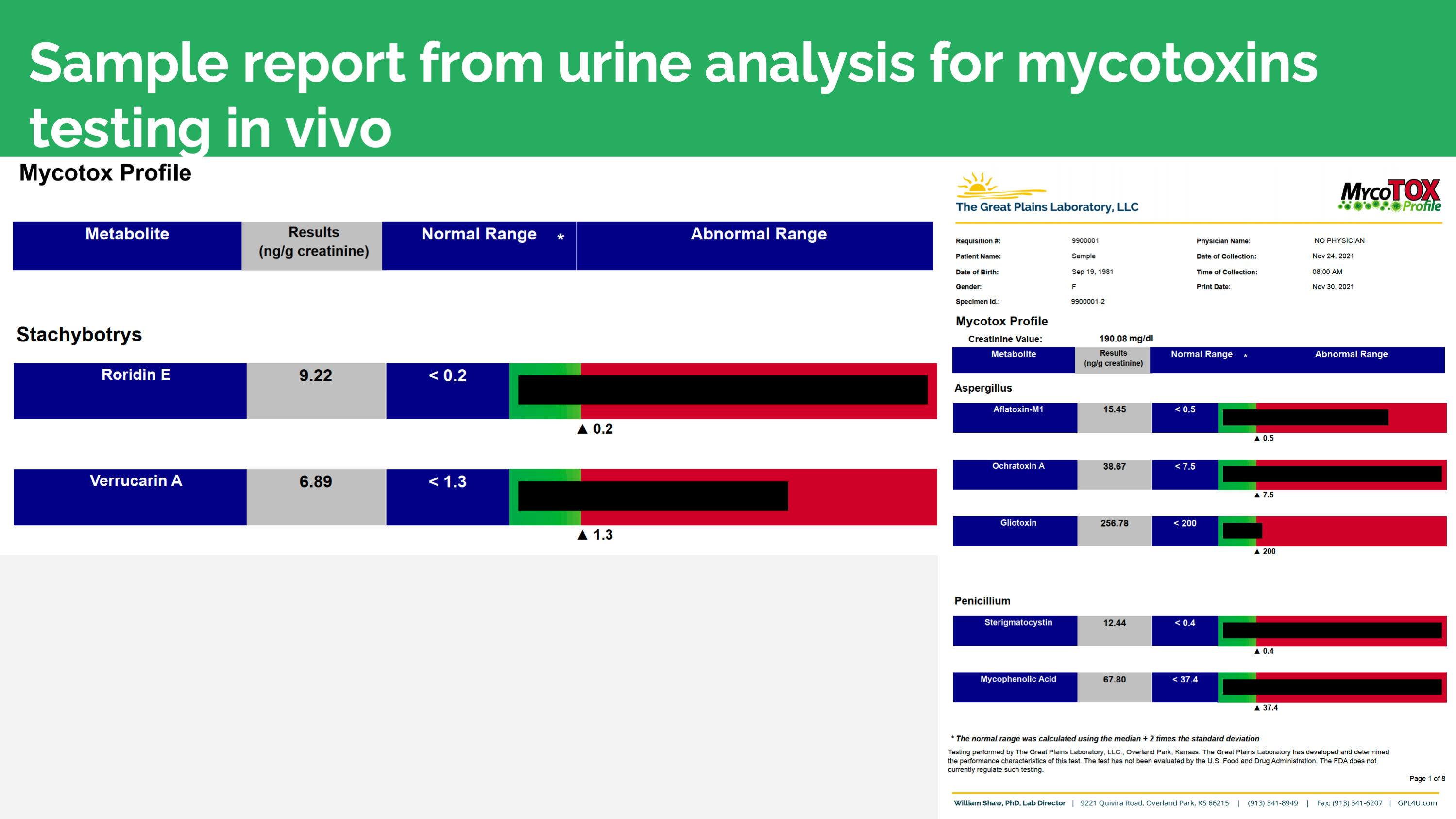
But moving right along. What is some of the research from the Finnish research showing? I have just taken out one of their typical tables where they were analyzing the mycotoxins in the urine. I mentioned, first off, they looked at what Mycotox returns. They are your classic mycotoxins like aflatoxin, but have a look at the top line. No one in that office building was exposed to aflatoxin. Now, aflatoxins are found on peanuts and on grains that are often water damaged, and it's a potent mycotoxin. But if you were to test someone using mycotoxin urine testing for aflatoxins, you might conclude that no one was exposed to aflatoxin.
Same for gliotoxin, another dangerous mycotoxin. Only one patient returned any appreciable value of this particular mycotoxin, and you can see that there are some other mycotoxins in the Mycotox urine screening panel which have zero values, meaning that the patient really didn't return any appreciable amount of mycotoxins and you could falsely conclude that even though they're complaining about a whole range of symptoms, there isn't any evidence that their urine contains mycotoxins and, therefore, no evidence that their physiology is being necessarily impacted on by these mycotoxins.
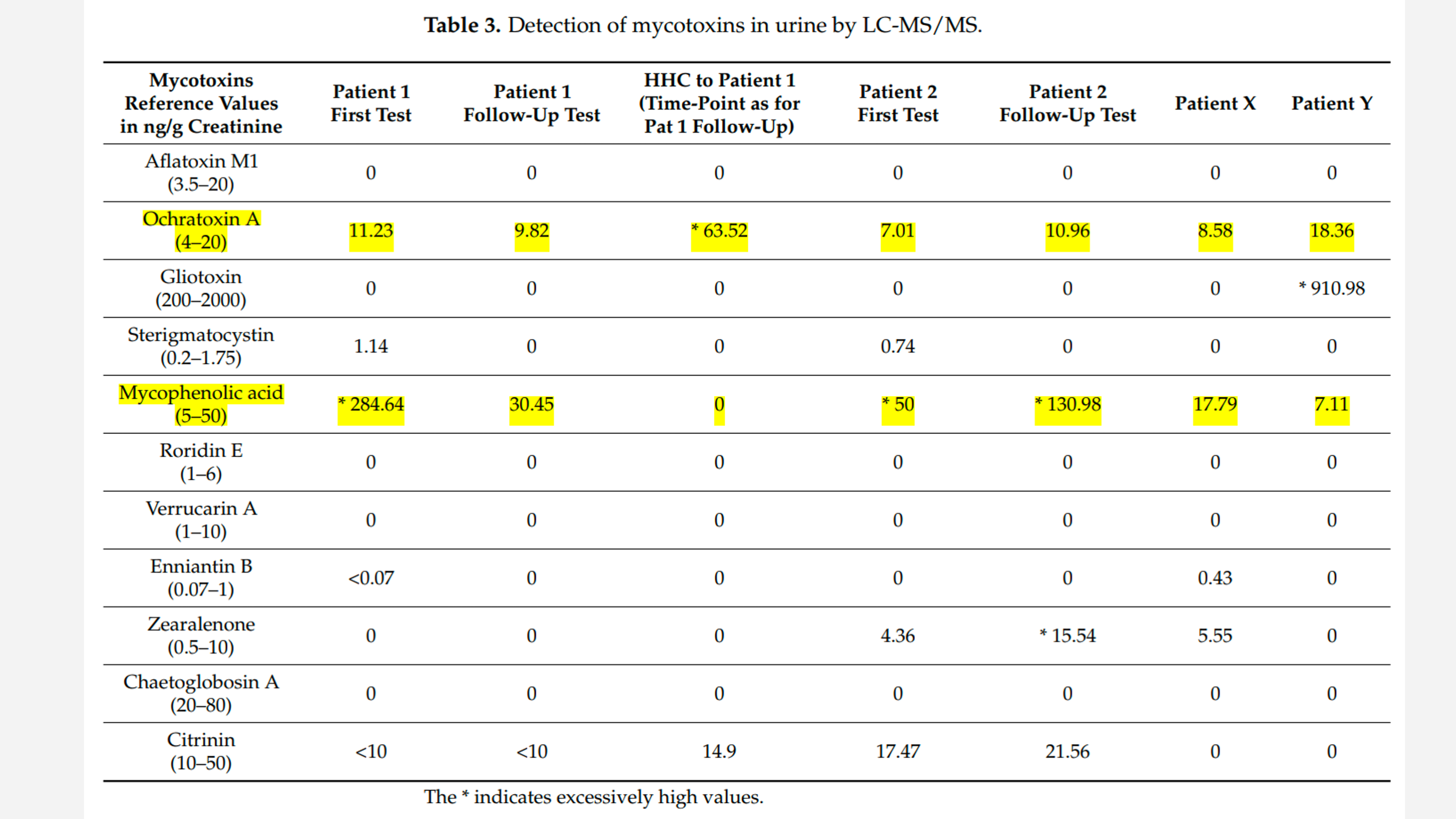
However, one of the mycotoxin panels for ochratoxin, which is certainly, I might add, carcinogenic in its own right, did show appreciable levels across all of the patients. However, the key finding in this publication, and why I think that this is going to go down as one of the most important publications of 2022, is that they identified a new metabolite, a new mycotoxin called mycophenolic acid. That's right, mycophenolic acid. You might immediately be thinking, well, how come it has the prefix myco on it? The reason it has that is that mycophenolic acid has been nearly a hundred years, mycophenolic acid is produced by specific fungi of the penicillin genus. But the interesting thing is that mycophenolic acid is used in the manufacturer of drugs that are used for tissue and organ transplant patients, and they are given drugs containing mycophenolic acid to suppress their immune system.
Why is this important? Well, imagine if the water vapor that you're breathing in contains mycophenolic acid, and imagine if this was detectable in your urine or the condensate that is forming with that Coke can effect on the rapidly cooled metal plate. Well, that's exactly what this research is saying, and we're going to move through some of this now. Why is mycophenolic acid so important? Well, I mentioned that it's an immunosuppressant. It is used as a drug and it is used to prevent or minimize rejection in people undergoing, for example, kidney transplants. There is some really good clinical data and publications out there showing that when the dosage of mycophenolic acid drugs isn't high enough or is started late, that patients show rejection much earlier. There is a very good correspondence between the amount of mycophenolic acid when it is used to actively suppress the immune system and the outcome for those transplant patients.
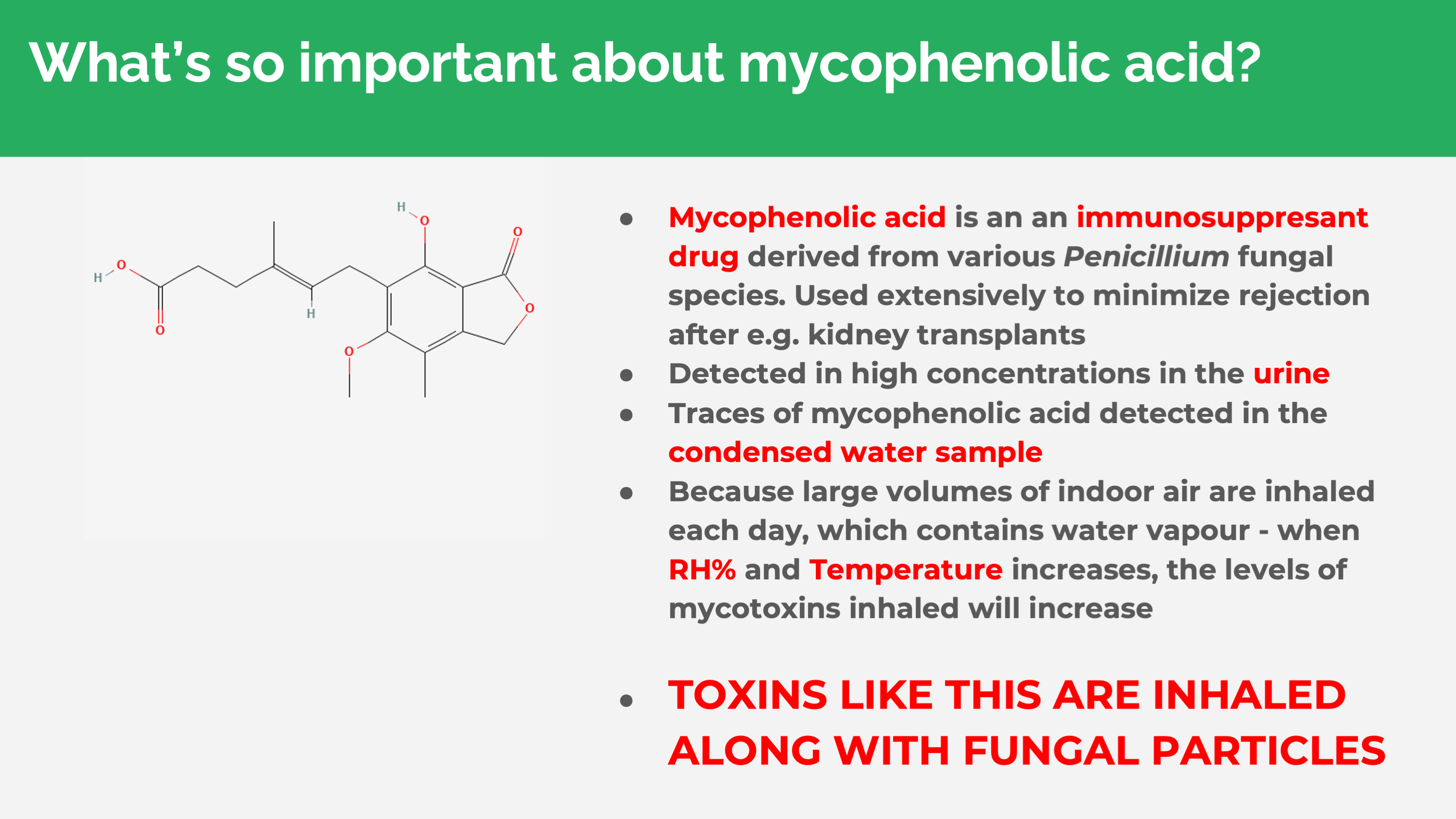
Taking that information on board, we can immediately make the connection that exposure to high levels of mycophenolic acid in the airspace that you're breathing in could suppress your immune system, and that's exactly what this research shows. What they found in their research results, clearly identified in this publication, is that high concentrations of mycophenolic acid were recovered in the urine and traces of mycophenolic acid were detected in the condensed water sample.
Now, before you race out there and think, "I've found the next million-dollar idea to measure mycophenolic acid in the environment," the scientists are stressing in their publication that the levels were particularly low and potentially, mycophenolic acid in the condensate was impacted on by things like light exposure, et cetera. They have to finesse some of the acquisition methods for collecting mycophenolic acid containing samples in the field, but I have every expectation that in the coming months and years, we're going to see a whole range of publications of scientists and clinicians going after and targeting mycophenolic acid.
The other thing I want to say about the amount of things like this mycophenolic acid as an active metabolite mycotoxin in the air is that this is related to not only the temperature indoors, but the relative humidity indoors, and as the relative humidity increases and temperature increases, we're obviously going to breathe in more amounts of water vapor in every breath that we consume. Therefore, toxins like mycophenolic acid are inhaled along with fungal particles.
Now, what I want to say is very briefly, before we drill into some of these specific data in the publication, is that they have used liquid chromatography, mass spectrometry to actually isolate and identify the dominant peak. Just remember that the peak in the graph on the right-hand side shows two overlapping peaks in red and blue. One of these is the control, which is a pure form of mycophenolic acid, and the other blue peak is actually from the patient's urine. You can see that there is a one-to-one correspondence between the pure form of mycophenolic acid and the same peak using liquid chromatography and mass spectrometry of mycophenolic acid. That's how they can tell that the exposure is actually from mycophenolic acid.
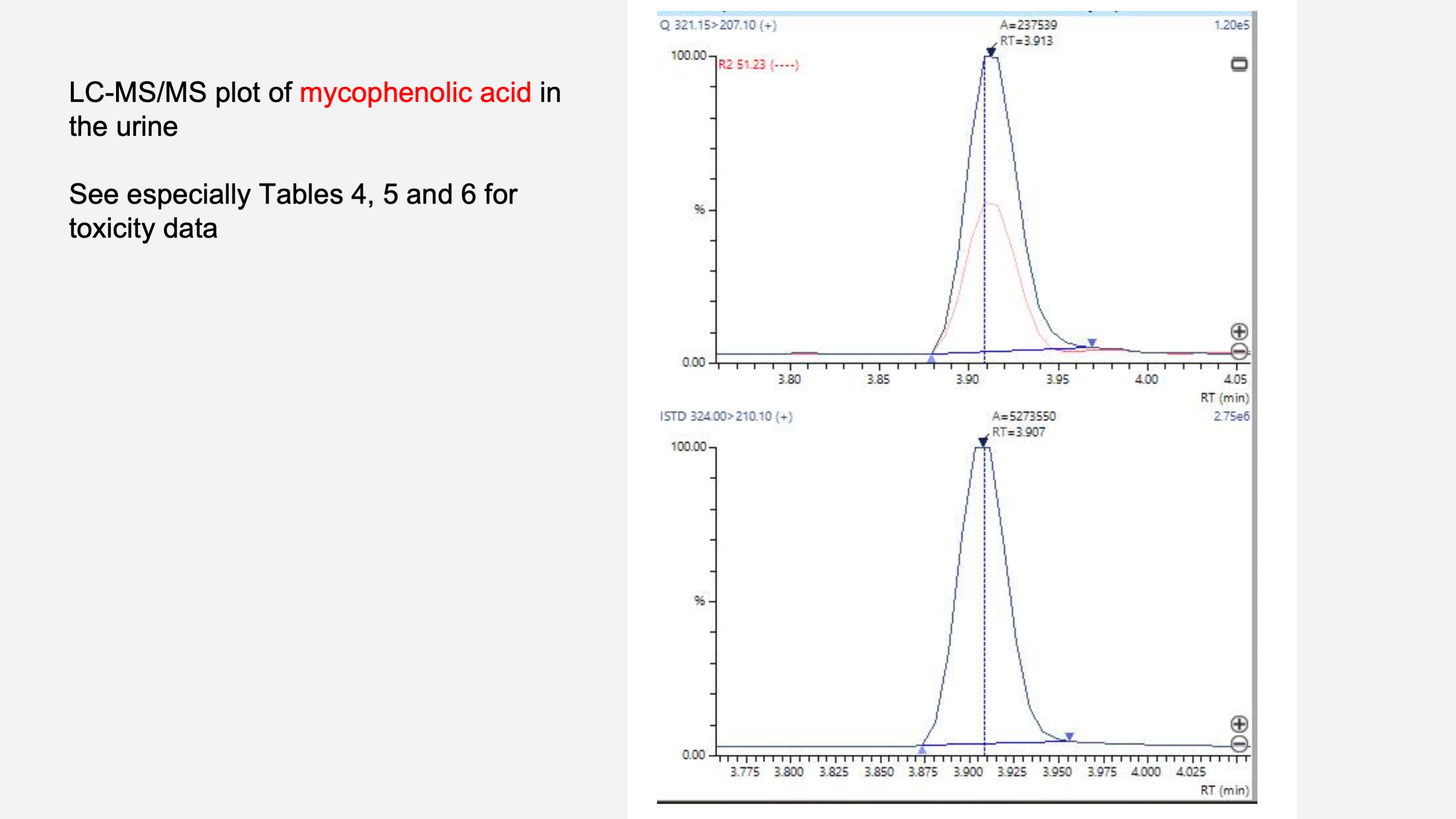
Now, what I want to do now is drill into the actual table. Now, remember we were talking about macrophages at the beginning, and I told you that they are involved in the ability to degrade or eat foreign invaders like bacteria and that sort of thing. What you can see on this particular part of the table four on the right-hand side, I'm going to just drill into this, is that you can see that there are a couple of different samples of the indoor air condensate taken from the office, and you can see the monocytes, the first column, and those are able to degrade things like bacteria, and then your general macrophages. You can see whole lot numbers in each row of the table.
But in order to interpret this, I want to just draw your attention to the highlighted section in the legend underneath the table, and I'll read directly from this to put this data into context. What it says, that negative values refer to a decrease in cellular viability. Positive values refer to an increase in mitochondrial activity or proliferation. Both are considered as adverse effects. On the one hand, we have monocytes showing a change in cell viability of anywhere from 7.66%, right up to 28.4%. Similarly, we can see a reduction in macrophage activity, which is a loss of cell viability, and we can see that for all of the macrophages anywhere from 2.87 to 9.54%. This is a significant impact on the ability of your body to cope with exposure to this toxic indoor air.
Now, if I draw your attention again to the next highlighted section, you can see that the scientists assessed the growth in the buildings using Petri plate culture, and similarly, when they looked at the BHK test and the boar sperm motility test, they were able to confirm ... If you cast your eye down the first red block showing the different samples for the types of microbes that were cultured from the indoor air, you can see that every one of those fungi was toxic to sperm tests. Remember that boar sperm indexes mitochondrial activity, which is in close relationship to what we saw for the change here, which is the negative values for the macrophages which indicates an increase in mitochondrial activity. The benefit of some of this research is you've got overlapping ways to measure the impact or the immunomodulation of these toxic materials.
Then when we look at the BHK-21 test, we see that some of the microbes are toxic, but some of them aren't. You can immediately see why this publication is so important because it is able to use a whole different type of testing strategies to confirm not only human exposure, but to recover the moulds that are contributing to the mould problem inside this office building, and thirdly, perform a range of different in vitro tests to see, the toxins in the water vapor, whether it interferes with cell activity, viability and mitochondrial performance, each of which is connected to our experience of positive, neutral, or negative adverse health.
The conclusion that the scientists make, because it's really, really important to see what they've concluded here, and what they basically say is that we know that mycophenolic acid based drugs are used to prevent rejection and that they are capable of switching off the immune system. They do this by interfering with B and T lymphocytes. Therefore, the hypothesis is that exposure to environments with high mycophenolic acid levels would explain why many people who are exposed to water-damaged buildings suffer from recurrent infections, because infections point to a dysregulation of the immune system. These can be local, like irritation to your mucus membranes, sinus infections, persistent coughs, or even more common skin infections or candidiasis, like systemic infections, which all impact on innate immunity.

The problem is that prolonged exposure to water-damaged buildings, prolonged exposure to substances like mycophenolic acid that are essentially invisible, could lead to uncontrolled cell proliferation and even contribute to cancer. We need to be very mindful every time any individual complains about exposure to water-damaged buildings and considers that their symptoms are related to spending time indoors.
The first thing obviously is to do a comprehensive indoor air quality and mould assessment. The second thing is that those individuals should consult with their healthcare practitioner and they should elect to have their urine tested for the presence or absence of mycotoxins, because whilst it might miss the mycotoxin that you are exposed to, then again, it might not, and it is an important set of data points which contribute to our understanding of toxicity in the built environment.
Thirdly, scientists and clinicians like myself should be following the literature. We should be looking for new biomarkers like mycophenolic acid, and even if they don't become immediately available in a commercial context, we should be at least accepting and reflecting on the fact that it's not just the mould spores, the physical particles or the fragments or the odors, but it is the other toxins like the mycophenolic acid that are all but invisible, but are present in the water vapor in every breath of air that you're breathing.
In any case. My name's Dr. Cameron Jones. I hope you found this a valuable contribution to your understanding of exposure to water-damaged buildings. All of the information is going to be available in the show notes, and also, this will be turned into a blog and a podcast and available on Facebook on biologicalhealthservices.com.au, as well as on YouTube. In any case, I hope you have a good week and see you next week. Bye for now.
Watch the Livestream:
REFERENCES:
Vaali K, Tuomela M, Mannerström M, Heinonen T, Tuuminen T. Toxic Indoor Air Is a Potential Risk of Causing Immuno Suppression and Morbidity-A Pilot Study. J Fungi (Basel). 2022 Jan 21;8(2):104. doi: 10.3390/jof8020104. PMID: 35205859; PMCID: PMC8877819. https://pubmed.ncbi.nlm.nih.gov/35205859/
Chanput W, Mes JJ, Wichers HJ. THP-1 cell line: an in vitro cell model for immune modulation approach. Int Immunopharmacol. 2014 Nov;23(1):37-45. doi: 10.1016/j.intimp.2014.08.002. Epub 2014 Aug 14. PMID: 25130606. https://pubmed.ncbi.nlm.nih.gov/25130606/#:~:text=THP%2D1%20is%20a%20human,of%20monocyte%20and%20macrophage%20activities.
Andersson MA, Mikkola R, Rasimus S, Hoornstra D, Salin P, Rahkila R, Heikkinen M, Mattila S, Peltola J, Kalso S, Salkinoja-Salonen M. Boar spermatozoa as a biosensor for detecting toxic substances in indoor dust and aerosols. Toxicol In Vitro. 2010 Oct;24(7):2041-52. doi: 10.1016/j.tiv.2010.08.011. Epub 2010 Aug 21. PMID: 20732404. https://pubmed.ncbi.nlm.nih.gov/20732404/
Dubreuil A, Hollande E, Bouley G, Boudene C. Effects of lead microparticles on the growth characteristics of the BHK21 fibroblast cell line. Toxicology. 1979 Aug;13(3):249-62. PMID: 524380. https://pubmed.ncbi.nlm.nih.gov/524380/
Vicente-Carrillo A, Edebert I, Garside H, Cotgreave I, Rigler R, Loitto V, Magnusson KE, Rodríguez-Martínez H. Boar spermatozoa successfully predict mitochondrial modes of toxicity: implications for drug toxicity testing and the 3R principles. Toxicol In Vitro. 2015 Apr;29(3):582-91. doi: 10.1016/j.tiv.2015.01.004. Epub 2015 Jan 23. PMID: 25624015. https://pubmed.ncbi.nlm.nih.gov/25624015/
Bennett, W., 2003. Immunosuppression with Mycophenolic Acid: One Size Does Not Fit All. Journal of the American Society of Nephrology, 14(9), pp.2414-2416. https://jasn.asnjournals.org/content/14/9/2414
Bosshart, H., & Heinzelmann, M. (2016). THP-1 cells as a model for human monocytes. Annals of translational medicine, 4(21), 438. https://doi.org/10.21037/atm.2016.08.53. https://www.ncbi.nlm.nih.gov/pmc/articles/PMC5124613/

